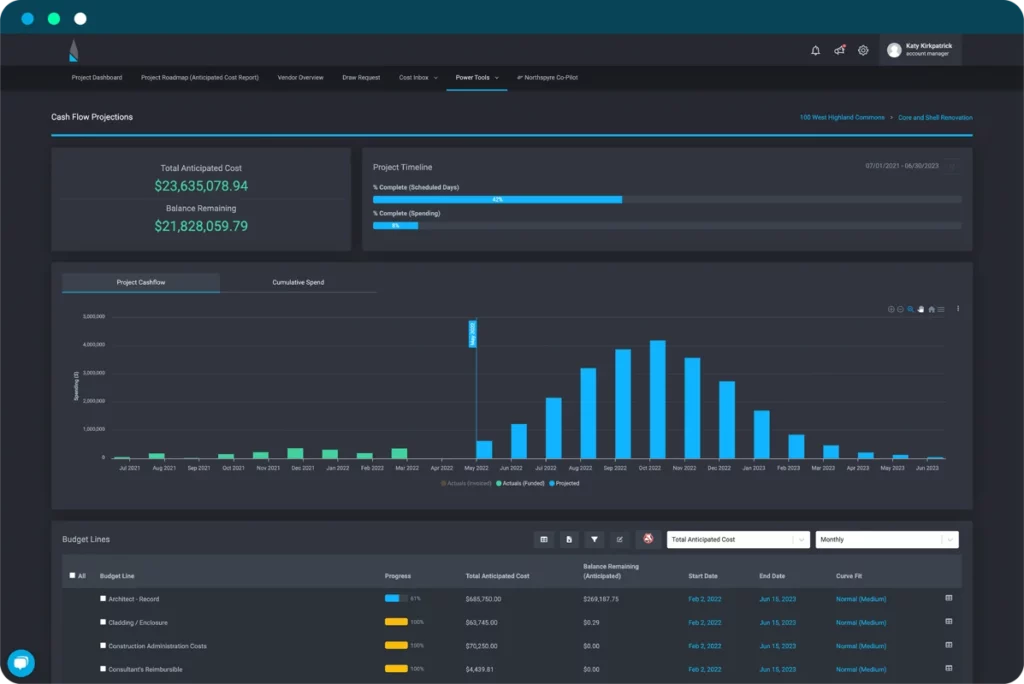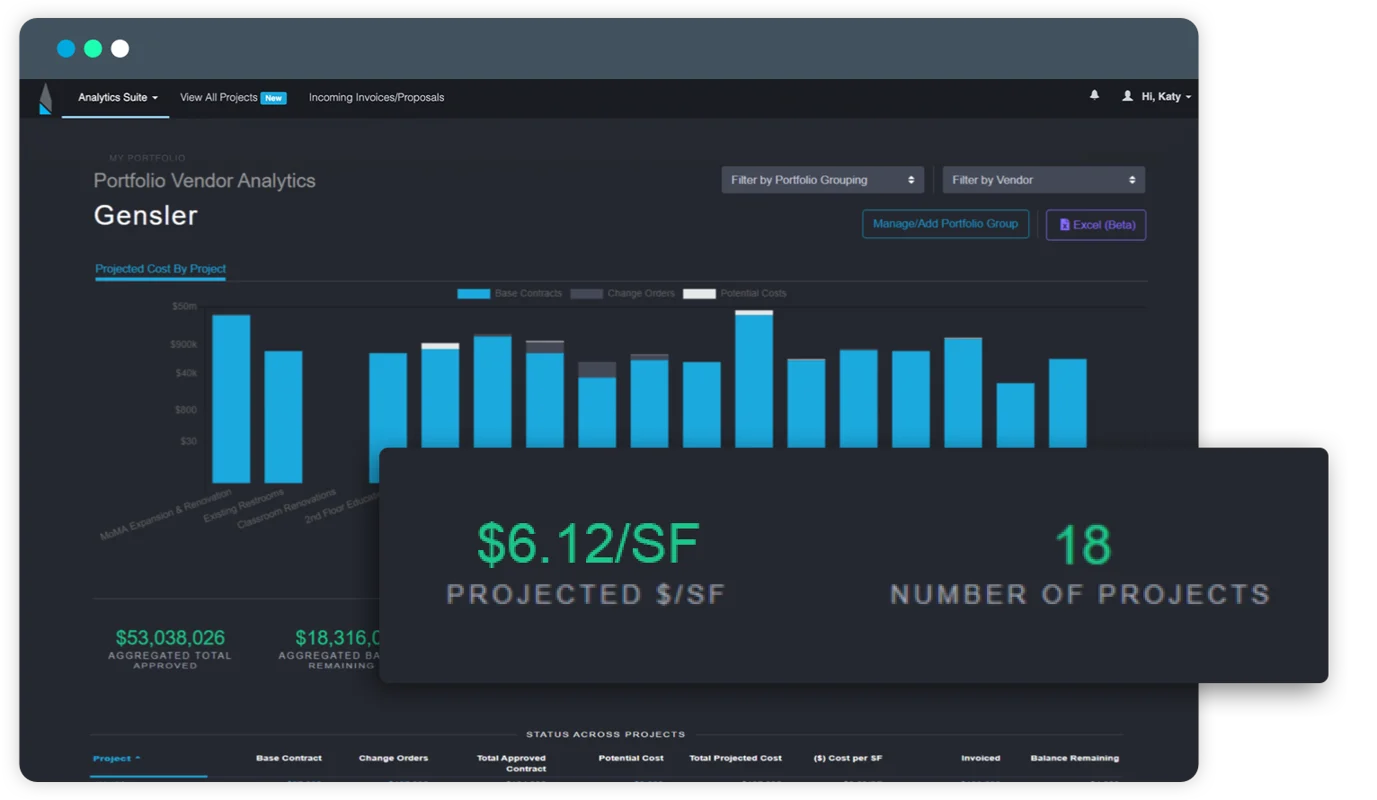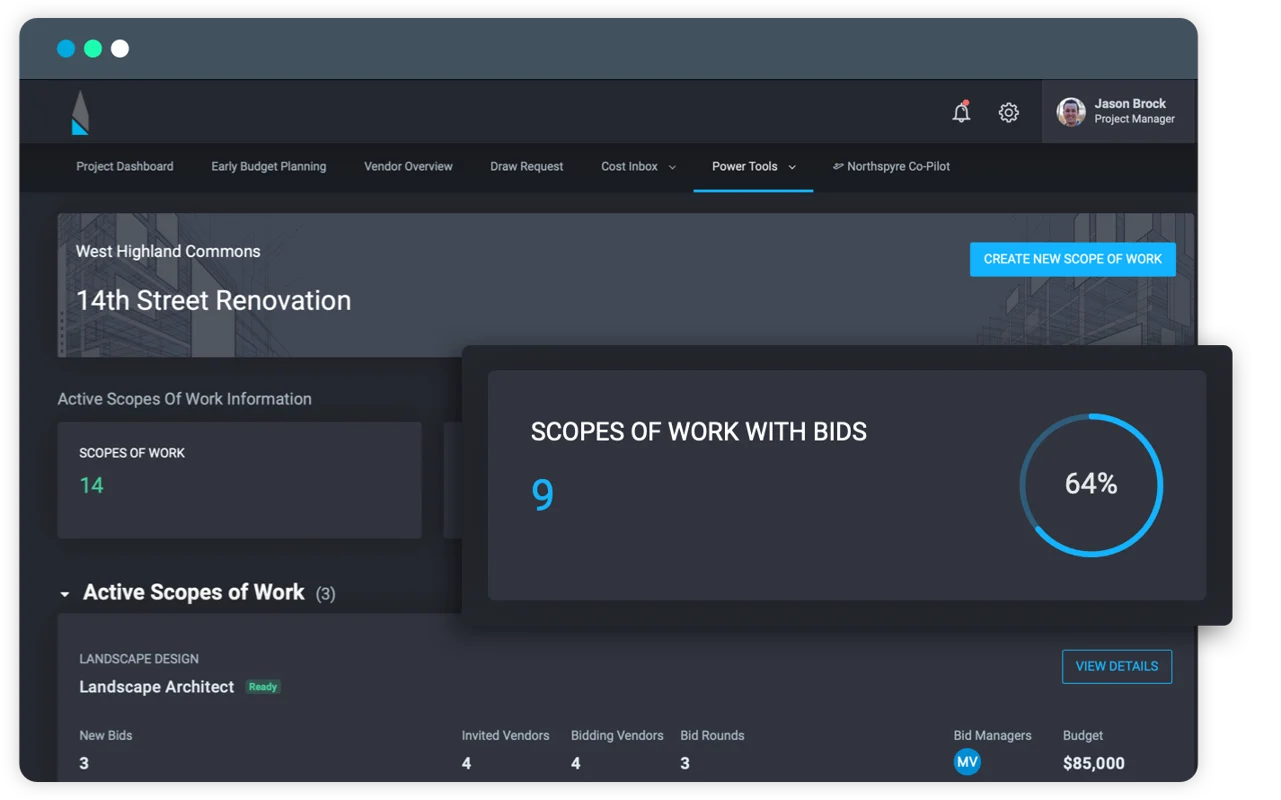The Ultimate Guide
Modern Real Estate Development Software
How developers are evolving with automation, analytics, and AI.

What is Commercial Real Estate Development Software?
Developers have started shifting their view of technology as the lack of modern software for real estate development teams has become universally recognized. Although many developers believe there’s no solution more efficient than spreadsheets, clinging to that notion can prove detrimental when other developers are adopting modern technology.
Modern real estate development software incorporates the latest in automation, data analytics, and artificial intelligence to increase workflow efficiency.
Artificial intelligence (AI) can have a transformational impact on your company. It can eliminate most of your manual administrative work, analyze and leverage data from your portfolio, create in-depth forecasts to reduce risk, produce actionable insights, and quickly generate key reports.
Automation is a powerful tool because it expedites workflows by completing time-intensive tasks like regularly updating your project spreadsheets so your teams can spend time on more critical tasks. It also prevents your firm from encountering data organization problems, like spreadsheets ending up on an individual’s hard drive or email.
Data analytics can significantly improve operational efficiency and project outcomes by indexing your projects’ bids, contracts, and change orders and aggregating that information into a single source of truth. Those insights enable greater project visibility and more informed decision-making.
Together, those features allow leading teams to focus on high-value tasks, make better decisions, and consistently bring projects in on time and under budget. They also enable organizations to overcome problems like:
- Depending on error-prone historical spreadsheets or ad-hoc meetings to make crucial decisions.
- Inability to contextualize vendor performance across past and present projects.
- Reviewing backward-looking reports that tell you what already happened on your project.
- Spending up to 30% of your time focused on tedious administrative tasks.
- Missing a crucial aspect of a dependable project delivery process because
your team doesn’t have easy access to project data.
That last point is one of the critical reasons developers are adopting real estate development software. The ability to provide transparency around project data and progress with easy-to-understand dashboards that remove communication roadblocks between teams, leadership, and investors while simplifying and improving the decision-making process.
In essence, real estate development software eliminates many of the pain points development teams have been putting up with for decades.

How Real Estate Development Software Works
How exactly does modern real estate development technology create a single source of truth for your project?
Let’s start with automation. Real estate development software syncs with your current email-based workflows to automate data extraction from incoming project documentation like invoices, proposals, commitments, and other backup documents. The data then flows through the system, populating real-time dashboards to give you and other stakeholders visibility into how your project is progressing.

The data flow doesn’t end there. Your team can then pull key industry-standard reports based on the real-time data being populated with every new project document. With real estate development software, you’re eliminating two significant time commitments from your day-to-day: manual data entry and report compiling.
You are building a single source of truth for all your projects that all stakeholders can access while reducing hours of administrative work. Using real estate development software for all of your projects leads to compounding benefits. Whereas most of your past project data is stored on various spreadsheets, modern solutions allow you to store and use historical data to inform project decisions.
Having data on how similar project decisions panned out can inform what you do on your current project. And when you can reference that past data quickly, it becomes easy to make informed choices instead of trusting your gut.
How Real Estate Development Software Aids Better Project Management and Outcomes
Modern real estate development software uses automation and data analytics to aid your project outcomes, but what about artificial intelligence? AI is used to track cash flow trends and flag budget lines that are trending high. This allows project managers to make real-time adjustments instead of backtracking to see where budget forecasts were off after the fact.
For example, if the system flags that labor costs are trending high, you can swap certain materials, like granite countertops, for similar-looking but cheaper materials to account for the budget line overrun. You’ve now prevented what would have been lost money without changing the project’s overall scope. Multiply this by the numerous budget lines across multiple projects, and the savings add up to a small fortune. It’s a great look for the project team responsible for making these budget-saving decisions.
With real estate development software, your project team is shifting their mindset to proactive, data-driven decision-making. With the backing of real estate development software your team is empowered to:
Mixed Use Development Project Checklist
Before moving forward with the complex construction process, you should create and consult a mixed use development project checklist. Here are the key objectives you should include:
Make Data-Driven Assumptions
During initial project estimates based on smartly indexed historical cost data.
Make Smarter Buyout Decisions
By evaluating vendors in the context of their peers.
Leverage Early Warning Systems
Alerting you to critical cost overruns and budget issues that might affect the successful completion of your project.
Get Ahead of and Manage Critical Risks
Challenges on your project.
How Real Estate Development Software Helps You Cut Costs
With the right intelligence platform, you can cut costs at each phase of the development process and make your entire organization more profitable.

Bringing a complex project to completion takes years of hard work involving managing hundreds of vendors and meeting the expectations of demanding stakeholders who expect a good return on their multimillion investments.
Operating in the sector has become more challenging in recent years due to rising inflation and a labor shortage. But like many other aspects of modern life, the advancement of technology has made many of the sector’s time-intensive tasks easier and faster to complete.
But modern real estate development software offers many advantages beyond improved efficiency

Enables Real-Time Expenditure Tracking
Complex projects often exceed their budgets because the teams working on them aren’t using a cost-tracking system.
Firms don’t end up with significant cost overruns because their spending isn’t recorded; it happens because vital information isn’t centralized. For instance, what happens if a vendor submits a change order reflecting the recent 3% price hike in ready-mix cement?
Once accounting receives this request, it’ll go through a multistep process approval process before hitting the project manager’s inbox. At that point, you will have to figure out how to cover the higher-than-anticipated cost without affecting other parts of the development process, and your options will likely be limited.
The big problem with that kind of manual workflow is that it forces decision-makers to make gut-driven, reactive choices that could have negative consequences down the line.
However, real estate development software enables teams to work on their project proactively via real-time expenditure tracking. A modern platform can capture change order information as soon as its received and integrate it into a centralized project database. Afterward, the platform will automatically generate forecasts showing how the higher costs will impact the budget several months into the future. And if the new data input creates a trend that will ultimately push the budget into the red, the AI-powered system will send you a predictive alert.
With access to real-time project data, the platform will give you actionable insights on problems like building material price hikes as soon as they happen. Leveraging the granular insights provided by real estate development software can help you significantly reduce overruns.
Eliminates Expensive Data-Entry Errors
Eliminating the costs associated with data-entry errors is another transformational improvement developers experience when using software built with development teams in mind.

A recent survey of real estate developers found that 95% of respondents use spreadsheets to manage their portfolios, which is understandable but unfortunate. On the one hand, programs like Microsoft Excel are great at storing vast volumes of data. But like many groundbreaking software programs designed in the 1980s, it replicates an analog process rather than improving it.
Like traditional paper worksheets, spreadsheets are vulnerable to data-entry errors. No matter how skilled or experienced, anyone can mistype information or click the wrong button. That’s why researchers have found that 90% of spreadsheets contain errors. Unfortunately, simple keystroke mistakes can have devastating consequences. In 2003, Canadian electricity company TransAlta lost $24 million to a cut-and-paste error, and a similar mistake cost JP Morgan $6 billion in 2012.
Using a spreadsheet program for project management makes you vulnerable to the same financial risk.
But real estate development software can protect organizations from the long-lasting consequences of data-entry mistakes. Thanks to their automated functionality, modern platforms remove the possibility of manual data-entry errors from the equation. Your team won’t need to spend long nights hunting for typos when creating draw request packages. And you won’t have to worry about a single mistake wiping out millions in revenue.

Reduces Employee Disengagement & Turnover Costs
Instead of spending countless hours compiling and validating reporting data, staffers can focus on the high-level, strategic decision-making you hired them to perform.
Real estate development firms that utilize a reliable software solution to support their work can expect to cut costs on more than individual projects.
When leadership frees their team from a lot of low-value work by automating tasks like expenditure tracking, data entry, and report building, they can significantly decrease employee disengagement and turnover.

Talent assessment provider Chally reports that replacing an employee costs up to 30% of their annual salary. Job posting advertising, background checks, signing and referral bonuses, and onboarding expenses can represent a significant portion of an organization’s operating expenses. And that’s not even factoring in the losses associated with the fact that it takes six to eight months for a new worker to reach full productivity.
That said, it’s important to remember that employee disengagement and separation costs are often preventable.
Chally noted that companies could reduce their turnover rates by 29 to 59% by keeping team members engaged with their work. And Gallup found that organizations that maintain cultures that prioritize engagement have 10% greater customer loyalty, 18% greater productivity, and 23% greater profitability than their competitors.
With all those advantages, the question isn’t if real estate development software can help your organization cut costs; it’s a matter of how much.
How to Leverage Vendor Data With Real Estate Development Software
Wouldn’t it be nice to know a vendor is reliable before you agree to do business with them? Real estate development can help your team leverage this invaluable knowledge. +

If your team stores historical project data in a centralized database, you’re in a much better position to predict a vendor’s performance before work begins.
The problem is that this invaluable information isn’t easily accessible. If that’s the case with your firm, your team likely isn’t making data-driven choices during the vendor procurement process. That means your project outcomes aren’t as predictable or good as they could be.
Let’s look into how centralizing your vendor data – including proposals, contracts, change orders, and invoices – with real estate development software – lets your team leverage multiple data points to quickly make pivotal decisions.

Understanding Institutional Knowledge
Historical information gathered from your portfolio serves as your organization’s unique institutional knowledge. The resource allows your firm to maintain project continuity even when individual team members depart your organization. Project leads won’t have to track down important information on potentially inaccessible laptops and email accounts.
Real estate development companies with access to a single source of truth for their employer’s institutional knowledge have a substantial advantage over competitors that only operate on instinct.
By inputting your firm’s institutional knowledge into a real estate development platform, you’re empowering your team to make choices based on hard data. With those analytical insights driving your decision-making, you’ll see more consistency in project delivery.
4 Ways in Which Your Team Benefits from Vendor Data Transparency
Commercial real estate projects are often complex, costing millions and requiring the services of hundreds of vendors. Your project development process may need everything from a site surveyor to a lighting designer. With so many moving parts, it’s no surprise that a project’s overall success depends on vendor performance. Each service provider must complete their respective tasks under the agreed-upon contract terms.
Something as crucial as vendor performance shouldn’t be left up to chance. Here’s a look at how real estate development software can mitigate that risk and ensure better project outcomes.
Using Past Performance to Select the Best Vendors
Data stored from past project projects should inform your decision-making process. With past vendor performance data at hand, your team can quickly determine which potential partners have a track record of being reliable and responsible.
Suppose a vendor has historically had the lowest bids but submits a higher-than-average number of change orders. In that case, you’ll know that their services are more expensive than they seem. Choosing a vendor that may have a high initial proposal but completes their work within your initial budget is the best option.
Making the best vendor procurement decisions will enable you to create a solid budget at the start of development and ensure the project development process is as smooth as possible.
Paying Invoices on Time
For your vendors to stay on schedule, they need to be paid on time. With hundreds of vendors on different payment schedules, it’s easy to lose track of which invoices are due at what time. If your team’s payments are late and vendors deprioritize your job, you could easily lose up to three days of progress each month. Ultimately, those delays can add up to months of lost time over the course of a multi-year project.
Real estate development software keeps your invoices organized. With that functionality, you can manage all vendor communications within the platform, so you’ll always know their progress and needs.
Clearly Communicating Any Changes
Vendors can only complete their job if they have all the necessary information from your team. That means clearly communicating any design, materials, or expectations changes should be a priority.
Utilizing a purpose-built, cloud-based platform for early project planning gives all team members and vendors access to the same information. The benefit of having a single source of truth is that no one works off outdated spreadsheets stored on hard drives.
Instead, everything is updated in real-time in the cloud. That way, no vendors unintentionally complete work that is no longer necessary, or working from old directions will result in losing time and money.
Anticipating and Accounting for Any Obstacles
To keep your development project running smoothly, you want to be proactive, not reactive. Real estate development software makes it possible to look ahead and identify important project trends and challenges. With that information at your fingertips, you’ll have insight into problems that could arise and impact your vendor’s jobs, like increased hard and soft costs.
Instead of suffering through delays to your schedule and cost overruns, you can readjust your strategy and keep ahead of any negative fallout.
Who Can Benefit From Using Real Development Software?
Real estate development software is purpose-built to address the needs of real estate developers. However, modern software benefits all parties involved with a project’s development throughout its lifecycle.

Senior Leaders
For real estate development firm leaders, purpose-built software supports more profitable and consistent project outcomes.
By enabling on-time and on budget deliveries, platforms protect firms from the reputation damage that results from implementing poorly informed strategies. In addition, having access to error-free and shareable reports allows leaders to build stakeholder confidence across the project’s development.
Leaders can also reduce employee churn and disengagement by equipping their workers with tools that remove low-value tasks from their daily workflows.

Project Managers
For real estate development firm leaders, purpose-built software supports more profitable and consistent project outcomes.
By enabling on-time and on budget deliveries, platforms protect firms from the reputation damage that results from implementing poorly informed strategies. In addition, having access to error-free and shareable reports allows leaders to build stakeholder confidence across the project’s development.
Leaders can also reduce employee churn and disengagement by equipping their workers with tools that remove low-value tasks from their daily workflows.

Owners and Owner’s Representatives
Owners and owner’s representatives gain greater project visibility and control through intelligent development platforms.
Being able to view a project’s total, remaining, and anticipated spend is crucial to maintaining a budget. That level of visibility is even more impact in the form of a user-friendly dashboard that requires minimal onboarding.
Like development firm leaders, owners and owner’s representatives benefit from being able to provide investors with real-time project updates.

Accountants
Real estate development software can optimize and accelerate the accounting processes in a few ways.
By centralizing project data, a cloud-based platform saves accountants from wasting time tracking down documents from employees in other departments or regions.
The software automatically captures and synchronizes project information from an organization’s email-based workflow into a single source of truth. Accordingly, it lets accountants can say goodbye to the tedious work of reconciling spreadsheet discrepancies.

Corporate Real Estate Development Teams
Corporate real estate development teams can optimize their workflows by utilizing purpose-built software and achieve better project outcomes. By leveraging the power of an AI-driven platform, teams can mitigate budget unpredictability, eliminate human-entry errors, and cut development costs by up to 8%.
How Excel Compares to Real Estate Development Software
Launched in 1985, the program was designed to be a general-purpose spreadsheet tool. Back then, it was a groundbreaking solution that helped establish the professional utility of personal computers. But a lot of time has passed since then, and what was once cutting-edge has become antiquated

Benefits and Limitations of Using Spreadsheets Instead of Real Estate Development Software
If your company uses Excel, you know its benefits and limitations.
On the plus side, the program can keep track of budget data, vendor information, invoices, contracts, and other documents. It’s also been around so long that you don’t have to show new hires how it works. And Microsoft provides regular updates and support for it because it’s part of its popular Office suite.
However, Excel isn’t purpose-built real estate development software. Spreadsheets are a generalist solution that developers have had to manually force-fit to meet their needs. And real estate project teams have found that its design constraints create inefficient, error-prone workflows and less predictable outcomes.

To start, it requires manual data entry. You must collect a bunch of emails, attachments, and even back-of-the-envelope notes, requiring many rounds of emails and phone tag between departments.
Then there is the joy of entering all that information into an endless number of spreadsheets. All that time-consuming administration work becomes incredibly tedious. Since draw request reports can include hundreds to thousands of pages, the data entry grind can quickly turn into burnout.
That brings up another big problem with using Excel as real estate development software; human error. Regardless of their level of experience and caffeination, people make mistakes. And those mistakes lead to reconciliation errors that can make the reporting process longer than it should be.
Lastly, Excel is a static program, and that doesn’t provide a lot of visibility. As a digital filing cabinet, it can store a wealth of information, but that information isn’t collated.
Answering a single project question, for example, your total spend with one vendor to date, requires sifting through a virtual pile of documents. And spreadsheets can only tell you what you’ve done in the past, which means your budgeting forecasts will be built on a foundation of guesswork.
Now that we’ve identified Excel’s biggest benefits and shortcomings let’s look at how it stacks up to a purpose-built management solution.
Like a spreadsheet, real estate development software can store all the salient information and documents related to a project. But since web-based platforms are dynamic, they can provide much greater visibility, functionality, and accessibility. The user can go from a comprehensive 30,000-foot executive view to a granular perspective in just a few clicks. If you have a question, you can find the answer on your office computer, home laptop, or the smartphone you use to watch Netflix on the way to work.
Next-generation project development solutions also bulldoze data silos and eliminate data entry. Modern platforms use artificial intelligence systems to gather, extract, and index the salient project information from your existing email workflow. That means no more phone tag, time-depleting data entry, or error-ridden spreadsheets. All that time and energy can be directed toward project acceleration and pursuing new opportunities.
Purpose-built programs offer more benefits, including greater efficiency and productivity. These solutions can examine your historical and current project information to generate precise forecasts and identify future challenges so you can mitigate them before they become costly disruptions. And it can identify opportunities for you to use your budget more effectively.
The biggest difference between spreadsheets and real estate development software is reactive and proactive workflows. Because of their advanced functionality, data-driven solutions can help you have easier, more predictable outcomes on your projects. And integrating a state-of-the-art real estate development platform into your existing workflow is a lot easier than you might think.

Embrace the Future of Real Estate Development
No matter what role a professional plays within commercial real estate, traditional processes, and manual tasks are wasting time, causing inefficiencies, and generating unseen errors.
Current technology is solving big real estate challenges.
The tools are not only reinventing the way professionals perform their jobs, but they are also transforming the commercial real estate industry as a whole, by:
– Creating more opportunities
– Driving efficiencies
– Mitigating risks
– Streamlining the process
– Generating better outcomes
– Eliminating mistakes
– Saving money, effort and time
– Decreasing overhead costs
– Finishing projects on time and on budget
– Allowing teams to focus on more important tasks

Real Estate Intelligence is just the latest innovation in commercial real estate.
Northspyre, a cloud-based intelligence platform, is making a major impact on the way projects are delivered across the industry. Northspyre eliminates data entry and other tedious administrative tasks, provides real-time access to critical project data, generates key actionable insights, increases visibility into project metrics, and mitigates potential risk.

See Northspyre in action
See how leading developers use Northspyre to work smarter at every stage of the development lifecycle.